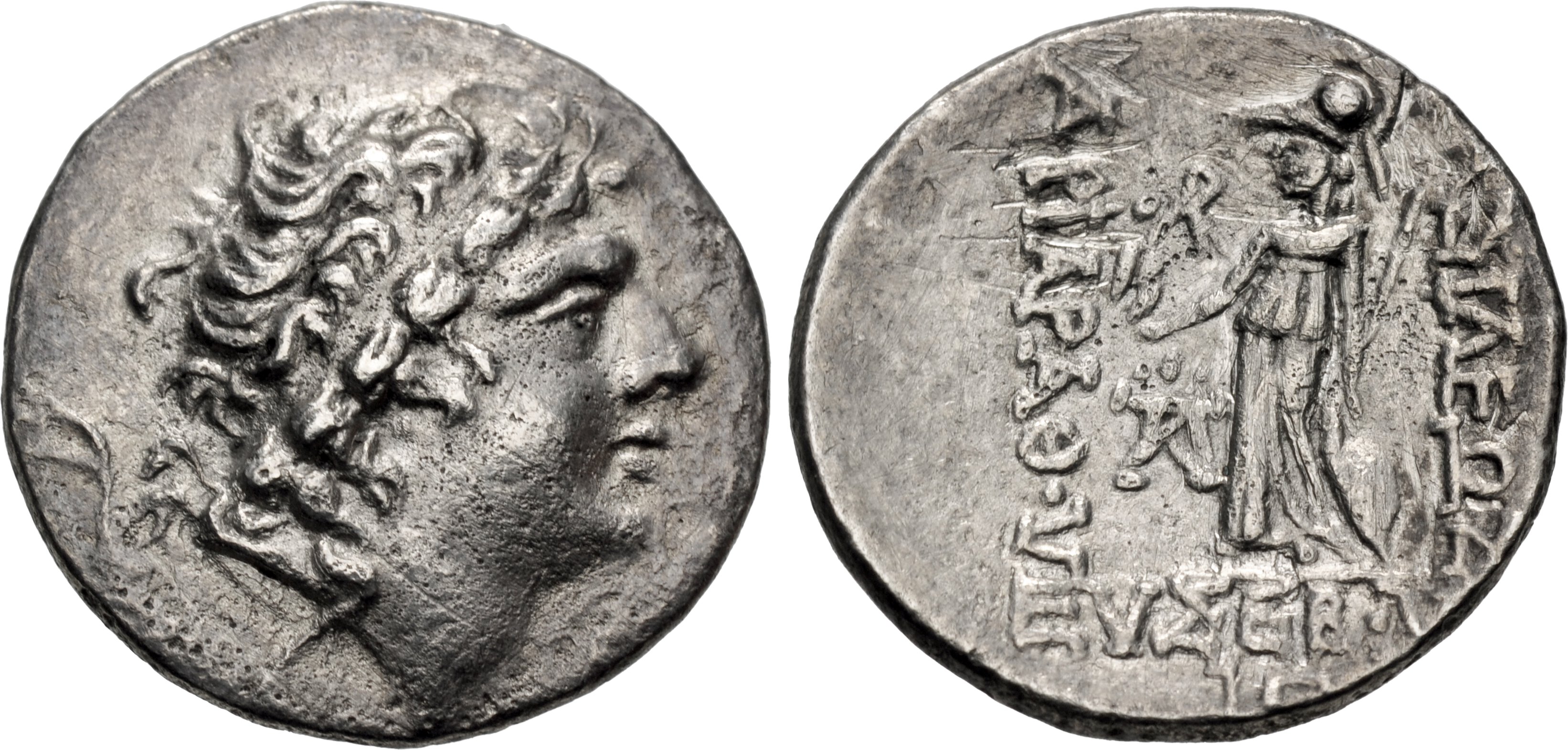H 274 - Eusebeia (Ariarathes IX), silver, drachms (97-85 BCE)
From SILVER
97 BCE - 85 BCE Silver 3,339 kg
Description
| ObverseInscription or printing placed on the obverse.: | Diademed head right |
| ReverseInscription or printing placed on the reverse.: | ΒΑΣΙΛΕΩΣ ΑΡΙΑΡΑΤΟΥ ΕΥΣΕΒΟΥΣ (Greek).Athena Nikephoros standing left, monogram to inner left, IΓ or IE (date) in exergue |
Mint and issuing power
| MintIdentifies the place of manufacture or issue of a numismatic object.: | Eusebeia | Ancient regionAncient region.: | Cappadocia | Modern countryModern country: Turkey | AuthorityIdentifies the issuing power. The authority can be "pretended" when the name or the portrait of X is on the coin but he/she was not the issuing power. It can also be "uncertain" when there is no mention of X on the coin but he/she was the issuing power according to the historical sources: | Ariarathes IX Eusebes Philopator (king of Cappadocia, c.100-c. 85 BC), Cappadocian kingdom |
Chronology
| FromIdentifies the initial date in a range assigned in a numismatic context. | 97 BCE | toIdentifies the final date in a range assigned in a numismatic context.. | 85 BCE | PeriodTime period of the numismatic object.: Hellenistic 323-30 BC |
Physical description
| MetalThe physical material (usually metal) from which an object is made.: | Silver |
Median weightMedian of the weights of numismatic objects (in grams). in grams | 4.00 | DenominationTerm indicating the value of a numismatic object. Examples: tetradrachm, chalkous, denarius.: | drachma |
StandardStandard.: | Attic |
Image

H274 Ariarathes IX drachms.jpg [1]
References
| Die study referencePublication of the study: | Callataÿ 1997a1Callataÿ 1997a, p. 180-184 | ||
| Coin series referenceReference to coin series study: | Sear II2Sear II, n° 7298-7299, RQEMH3RQEMH, n° 274, HGC 74HGC 7, n° 845 | ||
Obverse dies distribution
| FrequencyFrequency of specimen in distribution. ᵖ | Number of obversesNumber of obverse dies. ᵖ (o) | % (o) | Number of coinsNumber of coins. (n) | % (n) | Die nameName(s) of the die(s). |
| 1 | 13 | 37.14 | 13 | 10.16 | 6, 7, 12, 18, 22, 24, 25, 26, 27, 31, 32, 34, 35 |
| 2 | 8 | 22.86 | 16 | 12.5 | 3, 4, 13, 17, 19, 23, 29, 30 |
| 3 | 2 | 5.71 | 6 | 4.69 | 5, 20 |
| 4 | 1 | 2.86 | 4 | 3.13 | 16 |
| 5 | 2 | 5.71 | 10 | 7.81 | 11, 28 |
| 6 | 2 | 5.71 | 12 | 9.38 | 8, 21 |
| 8 | 1 | 2.86 | 8 | 6.25 | 14 |
| 9 | 2 | 5.71 | 18 | 14.06 | 9, 33 |
| 10 | 3 | 8.57 | 30 | 23.44 | 2, 10, 15 |
| 11 | 1 | 2.86 | 11 | 8.59 | 1 |
| Total | 35 of 35 | 99.99 | 128 of 128 | 100.01 |
Reverse dies distribution
no distribution is available
Quantification
| Number of obversesNumber of obverse dies. ᵖ (o) | 35 | Number of singletons (o1)The number of singleton coins. ᵖ | 13 |
| Number of reverse diesNumber of reverse dies. (r) | 101 | Number of coinsNumber of coins. (n) | 128 |
| Coins per obverse dieNumber of coins per obverse die. (n/o) | 3.66 | Coins per reverse dieNumber of coins per reverse die. (n/r) | 1.27 |
| Reverse per obverse ratioRatio of obverse dies divided by reverse dies. (r/o) | 2.89 | Percentage of singletons (o1)number of coins (n) divided by the number of singletons (o1) ᵖ | 37.14 % |
| Original number of dies (O) (Carter 1983 formula)The estimation of the number of coins according to Carter 1983 ᵖ | 41.74 | Coins struck if 20,000 as average productivity per dieCoins made if the average productivity for obverses (according to Carter) is 20,000. ᵖ | 834,800 |
| Original number of dies (O) (Esty 2011 formula)The estimation of the number of coins according to the singleton formula in Esty 2011 ᵖ (O) | 48.17 | Survival rate if 20,000 as average productivity per dieSurvival rate if average productivity is 20,000. ᵖ | 0.00015 |
| Coverage (o = % of O) (Esty 1984 formula)Esty 1984 - coverage (% of O) ᵖ (o = % of O) | 89.84% | Die productivity if survival rate 1/2,000Average productivity if survival rate is 1/2,000. ᵖ | 6,133.21 |
| Weight of silver (in kg) if 20,000 coins per die (O = Carter formula)Carter 1983 * Median weight * 20000 (*10 if gold or electrum) ᵖ | 3,339 kg <br /> 3,339 kg | Die productivity if survival rate 1/5,000Average productivity if survival rate is 1/5,000. ᵖ | 15,333.01 |
Remarks
Most likely one single workstation